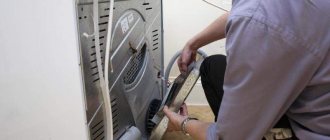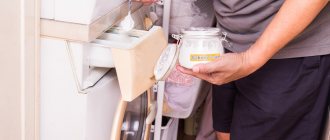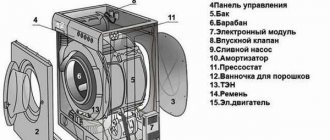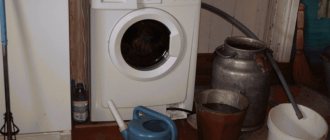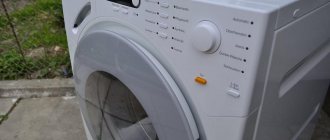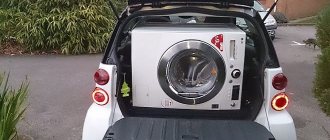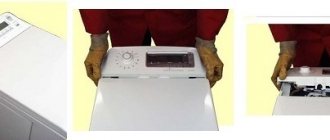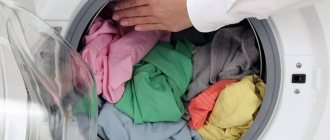Any washing machine needs special care. In addition to taking good care of your equipment, regular cleaning is recommended. Many people use expensive purchased products for this purpose, while others successfully use traditional methods. Cleaning a washing machine with soda is a procedure that can easily be done at home. Many people find it a simple and effective way to get rid of plaque and dirt.
Why soda?
The fact that soda can be used for household purposes comes as a surprise to many, because many housewives are accustomed to buying special cleaning products in chemical stores. In fact, this powder has many possible uses. One of them is cleaning washing machines.
To understand why soda turns out to be an effective means of combating washing machine contamination, you need to understand the issue of their appearance. For some, it remains a mystery how it happens that ordinary things are washed, and such “garbage” appears in the form of plaque, scale and dirt. In addition, an unpleasant odor appears, which is somewhat reminiscent of the smell from the bathrooms.
The answer to the question is simple: the water we use for washing is to blame. Unfortunately, most housewives do not have special filters for cleaning, and they cannot provide absolute purification of the water. In addition, water hardness negatively affects the condition of the metal from which the equipment is made. Therefore, plaque accumulates both on the drum of the washing machine and on the heating element. If you do not start to fight its formation in time, this can lead to breakdown of the machine, and in some cases to its complete malfunction.
Soda tends to have a softening effect. This is useful when the main source of plaque formation is excessive hardness of the water used for washing. In addition, baking soda is chemically alkaline, so it can dissolve harmful acids and other contaminants. Baking soda also has bleaching properties, which improves the condition and appearance of the internal parts of the machine. Thus, soda is a universal remedy that can protect the washing machine from various types of contaminants and extend its service life.
How to descale a washing machine with soda
Most often, scale forms on the washing machine filter, which can be easily cleaned with soda. To do this you need to take it out. Modern models provide easy pulling of the filter, so you can do this yourself. Some, out of ignorance, are afraid to do it themselves, so they call a specialist.
So, first you need to drain the existing water. To do this, place a small container, open the bottom cover of the panel, drain the water from the hose and take out the filter. We clean it outside and inside with soda.
There are two ways to do this:
- Prepare a soda solution. To do this, dissolve 2 tablespoons of powder in 0.5 liters of clean water at room temperature and mix. Then we lower the filter into the container with the solution and wipe it with a rag;
- Sprinkle a small amount of powder onto the filter and wash it carefully with a soft cloth. Then we rinse it in clean water.
If all the scale is not removed the first time, you can try cleaning again.
Instructions for use
Let's also consider other options for cleaning a washing machine with soda. First, let's talk about external cleaning. Oddly enough, some housewives simply wipe the top surface of the machine with a damp cloth, thinking that nothing will happen to it. In fact, after a few months, and maybe even years (it all depends on the quality and integrity of the manufacturer), the question arises of how to return the equipment to normal condition.
To clean the outside of the machine you will need baking soda, dishwashing liquid/gel, and a brush (you can use a toothbrush). For 1 liter of water, take 100 ml of detergent and add 100 g of soda. Mix the solution thoroughly and begin washing with a brush. The product can be applied to the walls with a sponge or rag, and a brush can be used to wash the door, rubber seal, and trays. After this, we wipe the entire machine, first with a clean damp cloth, and then with a dry one.
Now let's look at the instructions on how to clean the drum and other internal parts of the machine using soda. For this we need a pack of soda. Pour it into the powder tray, and pour the remaining part that does not fit there into the drum. Then select the fastest washing mode and the maximum permissible temperature. Turn on the wash and wait until the drum is filled with water. Then we wash “idle” and before the water starts draining, we pause. It is best to leave the machine in this condition for 2-3 hours. Then we finish until the end.
Housewives are very surprised how much garbage ends up inside the machine. If the functions allow, you can open the drum while it is standing and see how dirty the water is.
It is best to clean regularly with baking soda. How often this should happen depends on how often you use the machine. Experts recommend cleaning at least once a month.
How Often Should You Clean Your Washing Machine?
It is recommended to clean the washing machine at home at least once a quarter, and if you wash it frequently, it is better to do it once a month. The same applies to owners of furry pets - the presence of hair on things leads to rapid clogging of the drain filter. It is recommended to wipe the door seal and rinse the powder dispenser after each wash.
Cleaning the external elements - the outside of the cabinet and the door - is usually not difficult. It’s more difficult with the internal components of the machine, which are difficult to access.
Soda and vinegar
Vinegar is another handy remedy that is probably in every home. It can also be used to clean the washing machine, perfectly complementing the beneficial properties of soda. It is best to use alcohol-based white vinegar. You can buy it in household chemical stores. If this is not possible, then you can use regular 9% vinegar.
First, prepare the solution. Take 0.5 liters of vinegar, 0.250 g of baking soda and 0.250 ml of water. We also prepare a sponge; it is advisable to take one in which one side is made of a hard material, but it should not be a brush. Mix soda with water. This solution will be poured into the tray into which the powder is usually poured. It is also advisable to clean it first; this is why you will need a sponge. We wipe the tray with a sponge, moisten it in a small amount of soda solution, and pour the solution itself there. Pour the vinegar into the drum.
After this, we start the wash, choosing the mode that takes the longest time. It is also recommended to select the maximum drum rotation speed. After the first cleaning, you will be able to open the machine and notice an excellent result. If necessary, cleaning with soda and vinegar can be repeated several times in a row.
How and with what to CLEAN a washing machine from dirt and scale at home? — 8 traditional methods
If you find that instead of the aroma of freshness, your machine and washed items give off an unpleasant smell of dampness, then the equipment needs cleaning. And the sooner you take care of it, the greater the chance that the car will not break down, you will not have to replace expensive parts and spend money on calling a specialist. You can get rid of dirt, scale and unpleasant odors in different ways. To remove scale and mold, there are several fairly effective methods using improvised means that are easy to find in any kitchen.
No. 1. Cleaning with soda
Cleaning with soda
There are many special products to remove dirt and mold from the washing machine. If you don’t have them on hand, you can use regular soda.
Baking soda should be diluted with water in a 1:1 ratio and mixed thoroughly. Then put on rubber gloves, apply the resulting paste to a sponge and treat the contaminated surface. Then rinse the paste thoroughly and turn on the machine in rinse mode.
No. 2. Cleaning with soda and citric acid
Cleaning with soda and citric acid
Plaque and scale form on the tank and heating element for a number of reasons:
- tap water with a lot of impurities;
- washing powders with chemical additives;
- frequent use of equipment in intensive washing mode.
Attention! Scale should be removed in a timely manner, as it can lead not only to the appearance of foreign odors, but also to damage to the heating element.
Soda in combination with citric acid will do an excellent job of removing scale that has formed on the internal surfaces. To do this, 3 teaspoons of soda and 150 g of citric acid are mixed and poured into a pre-cleaned tray for washing powder. Then you should turn on the empty machine (it is advisable to select the program with the highest temperature), and after finishing the washing mode, rinse additionally. If you are confused about turning on the machine with an empty drum, you can throw an old rag or an unnecessary towel in there. You cannot combine cleaning and washing clothes, as this can ruin things.
No. 3. Cleaning with vinegar
Cleaning with vinegar
9 percent vinegar will help in the fight against mold and mildew. 2 glasses of vinegar are poured into the liquid detergent compartment, then the machine is turned on, selecting a high-temperature wash mode for 10-15 minutes. Then you should pause the machine and leave it for several hours so that the vinegar solution acts on the scale and eliminates harmful microorganisms. Then the washing is resumed, and at the end of the procedure, the machine is put on an additional rinse.
Using a vinegar solution, you can also treat the rubber seal of the hatch, carefully pull the rubber, remove all debris from the folds, and then wipe with a dry cloth. After cleaning, it is better to leave the door open for a while so that the drum dries out and the damp smell does not reappear. Many housewives add a little vinegar during the washing process to prevent scale formation. It softens the water a little.
No. 4. Cleaning with bleach
Cleaning the washer with bleach
Chlorine helps fight mold and is often used to disinfect washing equipment. To do this, pour half a glass of white into the drum, turn on a high-temperature washing program and wash for about 40 minutes. After this, an additional rinse will be required. Whiteness should not be overused: you should use it to clean your washing machine no more than twice a year.
No. 5. Cleaning the heating element
Cleaning the
heating element Sometimes the layer of plaque on the heating element is so large that it requires mechanical cleaning. However, in order to remove the heating element from the washing machine without damaging its operation, and then place it back, you need to have certain skills or strictly follow the instructions:
- First you need to determine the location of the heating element and remove the panel.
- Disconnect the wires and sensor, loosen the fastening and carefully remove the heating element using a flat-head screwdriver. Do not damage the wiring or tank.
- You can remove the main layer of plaque using the hard side of a sponge or fine-grain sandpaper. Do not use a knife or other hard tools as they may damage the device or leave scratches.
- To remove remaining dirt, the heating element must be soaked for several hours (preferably overnight) in vinegar diluted with hot water or in a solution of citric acid, then clean it with a toothbrush and rinse with running water.
- Wipe the clean device with a dry cloth and put it back in place.
No. 6. Citric acid anti-scale
Citric acid against scale Citric
acid will help you get rid of scale on the drum and heating element without disassembling the machine. When heated, it actively affects plaque, corroding even heavily caked limestone.
We pour about 100 g of acid into the tray (depending on the load - 30 grams per kilogram), then turn on the machine in the longest wash mode at maximum temperature, and after that - in the additional rinse mode. If after this procedure the smell does not disappear, it should be repeated. However, if the washing process is heavily soiled, it is better to interrupt the washing process in the middle and leave the machine alone overnight. In the morning, continue washing again.
You should not add a large amount of citric acid and use this method often, since regular use of the product can lead to damage to some parts of the machine. After cleaning yourself, be sure to check the drum rubber and drain hose for loose limescale particles.
No. 7. Descaling with baking soda and vinegar
Baking soda and vinegar Limescale
deposits can be removed using baking soda and vinegar. Soda and water in a 1:1 ratio are mixed and placed in a tray. Then a glass of vinegar (9%) is poured into the drum. Next, turn on the machine in the maximum temperature and duration mode.
No. 8. Cleaning with specialized products
Special cleaning products
In the assortment of hardware stores you can find a large selection of specialized products for cleaning washing machines at home. Their undoubted advantage is their composition, which contains only those components that effectively remove contamination and do not cause harm to equipment elements. Depending on your preferences and financial capabilities, you can choose products produced in powder or gel form from various brands and manufacturers.
There are both universal tools and specialized ones designed to fix any one problem with your own hands. Among the universal ones is Beckmann. It eliminates unpleasant odors, dirt, and scale. Suitable for regular use, but does not always cope with heavy dirt.
Popular store-bought products for removing scale from a washing machine:
- Magic Power – effectively removes plaque;
- Topperr 3004 – copes well with any degree of scale, and is also suitable for dishwashers;
- Schnell Entkalker – quickly removes stubborn lime deposits;
- Filtero 601 – effective in the fight against old scale, it is recommended to use once every 3 months;
- Antiscale - designed to combat scale in any household appliances, it has a good price-quality ratio.
It is also recommended to use special products during washing to prevent scale formation. They are added to the powder or directly into the drum before regular washing.
Soda and citric acid
Citric acid can be used as a stand-alone washing machine cleaner or combined with baking soda. If you use only it, then one procedure will require up to 6 packs of acid. Housewives note that it is the combination of soda with citric acid that brings excellent results.
To do this, you need to take 4 packets of citric acid (they are usually sold in 30 g volumes). You will also need 100 g of soda. Pour both acid and soda into the powder tray, select the longest and fastest washing mode and turn on the machine.
This cleaning method is effective due to the action of acid, which enhances the effect of soda and both substances cleanse the machine of salts and metals that have accumulated due to water hardness. Moreover, with regular use of this method, the scale that formed a long time ago will be gradually removed.
Cleaning the washing machine from scale, dirt and unpleasant odors
During service, lime and calcium salts are deposited on the heating element, leading to breakdowns. Because of them, the machine fails. Plaque forms when using intensive washing and high temperatures. The condition of the device is worsened by low-quality powder containing aggressive chemical elements.
Dirt, fabric fibers, and debris accumulate on the washing machine. In an unfavorable environment, a fungus forms, which manifests itself as a putrid odor inside the device. Filters and hoses rot, and the machine cannot be used.
Regular cleaning with sodium bicarbonate reduces the likelihood of damage. A clean heating element heats up faster to the set temperature, saving energy.
Expert opinion
Advice!
Baking soda is a universal substance for cleaning your machine from limescale and dirt. Sodium bicarbonate acts as an adsorbent that removes fats and deposits. In an alkaline environment, bacteria stop multiplying and then die. The fungus that disables the washing machine disappears.
The chemical element neutralizes calcium salts and makes water softer. Sodium bicarbonate is considered a gentle, non-toxic agent that effectively acts on scale and grease.
Kitchen sodium bicarbonate is used for cleaning and disinfection. For deep professional cleaning, soda ash is used. The element contains strong alkalis and is considered aggressive.
To enhance the effect of regular baking soda, the following components are additionally used: vinegar, citric acid. The result appears after the first procedure if the products are used correctly.
Recommended for you:
How to clean a kettle with baking soda at home
Cleaning the washing machine with soda ash
High-quality cleaning of the washing machine can be done using soda ash. This substance is more aggressive than ordinary baking soda, so the first rule for its use is the need to work with gloves. If soda ash gets on the skin, it will cause a burn.
To clean your washing machine you need to:
- Make a soda solution. To do this, take 100 g of soda ash and dilute it in 100 g of clean water at room temperature, stir until a homogeneous mixture is formed;
- Apply the mixture to the drum and the rubber layer around it. It is in the folds of this rubber layer that usually contain the largest amount of scale, mold and other contaminants;
- We wait half an hour and remove the mixture along with the dirt using a sponge, while trying to remove all residues;
- We turn on the wash “idle” to make sure that all the soda ash is removed. We select any mode, while turning on the maximum speed.
Washing Machine Prevention at Home
As in other areas of life, timely prevention can significantly extend the performance of washing equipment and save money for its owner. To do this, you need to remember a few simple rules and remember to follow them when using household appliances.
- We use strictly the required amount of powder; the principle “more is better” does not work here. We put exactly as much detergent in the container as indicated in the instructions. Otherwise, excess powder, especially if it is not of the best quality, will simply settle on the surfaces of the machine and will “delight” you with unpleasant odors.
- To avoid clogging the drain filter, do not forget to check your clothing pockets before washing: there should be no particles left in them, even small ones.
- Do not store dirty items inside the washing machine; use a specially designed laundry basket for this. The combination of dirty items and moisture can lead to an unpleasant odor that can be difficult to get rid of. After washing, immediately remove the items and send them to dry.
- After washing, do not immediately close the hatch cover, let the drum dry. You should also leave the powder tray open.
- To avoid scale build-up on the heating element, it is recommended to add special agents to the washing powder while the machine is operating to prevent the formation of plaque. You can also purchase a special filter for the water supply hose.
- After washing, do not forget to wipe the drum, hatch door and rubber seal dry, and regularly rinse and dry the powder tray.
- Lint items must be placed in a fine mesh bag before washing. This will prevent small fluff from getting inside the machine.
Here are some washing machine cleaning tips to help make it more efficient:
- use chlorine-containing products with caution, as they can damage the rubber elements of the machine;
- Do not combine cleaning with washing, as aggressive substances contained in cleaning products can ruin your things. If you don't like spinning the drum in vain, fill it with unnecessary rags;
- heat and moisture, without which no wash is complete, lead to the formation of plaque, which feeds bacteria and contributes to the formation of an unpleasant odor. Plaque is not easy to see, but its presence can be established using a simple experiment: place a clean piece of cloth in an empty machine and put the machine on a short wash at high temperature (without adding detergents). If after a few minutes of operation you notice foam through the glass of the sunroof, rest assured, there is plaque in the car.
- Do not use vinegar as a cleaner if you used chlorine bleach in the previous cycle, as it is highly inadvisable to mix them. It is also not advisable to pour vinegar into the machine through the bleach dispenser;
- do not forget to use rubber gloves when cleaning;
- even if you usually choose a low-temperature mode, do at least one wash a month at a temperature of at least 60 (preferably 90) degrees to get rid of bacteria and germs that have settled in the machine;
- Clean items from heavy soiling before putting them in the washing machine.
Regular cleaning of your washing machine at home helps to avoid serious problems and breakdowns. Timely cleaning is especially important for those who have hard water in their homes, do laundry frequently, or have furry pets. Thus, scale on such an important element as a heating element can lead to its malfunction, and then to breakdown of the heating element. It is much easier and more economical to clean regularly. Moreover, for this it is not necessary to buy expensive products or use the services of specialists. Pay a little attention to your household appliances at least once a month - and they will delight you with their proper functioning for a long time.
What is the difference between baking soda and soda ash?
Baking soda is more popular than baking soda. This is explained by the fact that its chemical composition makes this product harmless to humans, so we even use it for oral administration, for example, in baking or drinking the popularly known “fizzy drink” for heartburn.
By their nature, both baking soda and soda ash are alkaline. However, their chemical formulas are different. Baking soda is the weakest alkaline product compared to soda ash or caustic soda. Caustic soda is so powerful that it is used only in the chemical industry; it is dangerous for humans. As for soda ash, it is this that is in greatest demand when used for household cleaning. Its chemical composition is not so weak that it should be added to baked goods, but also not so aggressive that its use should be avoided altogether.
Cleaning recipes with baking soda, vinegar and citric acid
An effective way to clean a washing machine is to use vinegar and NaHCO3. The recipe eliminates scale and prevents the development of fungus. Cleaning occurs after activating the device.
A vinegar solution is placed in the contents of the drum, and 3 tablespoons of baking soda are added to it. The wash starts in boiling mode, all items are first removed from the drum.
Recommended for you:
How to use baking soda to remove unpleasant odors and clean your refrigerator at home
After the cycle is completed, 100 ml of 9% vinegar is added to the drum, after which the mode of the same name is activated. At the end of the procedure, the doors are wiped with a napkin, and the filter is cleaned of any remaining dirt.
Vinegar may leave a negative odor emanating from the inside of the device. To eliminate it, turn on the idle rinsing mode and thoroughly wipe the machine.
A mixture of citric acid and soda ash quickly removes limescale deposits from the faucet area. Use 150 g lemon powder and 15 g NaHCO3. The mass is placed in the detergent tray, then the rinse mode is set to high temperature.
NaHCO3 cleans the washing machine no worse than galangal, while being affordable and safe. With the additional use of citric acid, scale and mold are quickly eliminated. The procedure is carried out as needed, on average once a month.
How else can you clean your washing machine?
There are actually many ways to clean your washing machine. When deciding which one to choose, you need to proceed from the availability of a particular product and the condition of the machine. In some cases, when no one has looked after the equipment for years, it is best to contact a specialist who will conduct a technical inspection and assess the general condition.
For those who decide to care for the equipment themselves, the following options are suitable:
- "Calgon" and other purchased products;
- Bleach;
- "Antiscale";
- Whiteness, etc.
In fact, a product that is suitable for one washing machine may not only not help, but also harm another. Therefore, you should always first consult with a specialist or carefully study the features of the model and technical characteristics of your equipment.
Cleaning the washing machine with folk remedies
Dealing with the smell is sometimes not easy, but it is possible. To do this, you need to accustom yourself to periodically give your car a general cleaning.
For the procedure we will need:
- Rubber gloves (medical or regular, purchased at any hardware store).
- Soft cloth, napkin or sponge.
- Cotton buds.
- Unnecessary toothbrush.
- Baking soda.
- Lemon acid.
- 9% table vinegar.
Baking soda is one of the most effective cleaning agents. Anyone who has ever cleaned scale and grease from dishes and other household appliances knows about its universal properties. Soda is also used in cooking, it is used to remove stains from clothes, and is also used as a bleach.
Here are some tips on how to clean your washing machine with baking soda:
- Wear rubber gloves to avoid an allergic reaction and irritation of the skin of your hands.
- Mix soda with water until a homogeneous mass is formed (ratio 1:1).
- Apply the resulting mixture to places where mold most often forms: machine drum, cuff folds, tray (or container) for loading powder. You can also use cotton swabs and an old toothbrush to clean hard-to-reach places and small parts.
- Do not rush to wash off the soda solution: it is better to leave it for 30-40 minutes.
- Using a sponge or soft cloth, thoroughly wipe the contaminated areas.
- Set the quick wash program. Do not load laundry into the hatch: for cleaning purposes, the machine is started empty.
High-quality cleaning of a washing machine is possible not only with soda, but also with other well-known folk remedies. For example, citric acid. To clean the tank, about 200 grams of acid is enough. This amount can be poured directly into the drum of the washing machine or into the powder tray - depending on what exactly you are going to clean.
One of the most effective compositions for cleaning the inside of a washing machine is table vinegar (9%). Pour it into the machine tray and run a long wash cycle at high temperature. Do not load laundry into the hatch. After an hour, you need to pause the machine, wait about an hour and after a break, start the wash cycle again.
When the cleaning procedure is completed, do not forget to wipe all elements with a dry soft cloth or cloth. It is better to leave the drum of the machine open so that it is ventilated and after some time the unpleasant smell of vinegar evaporates.
We suggest you read How to clean a polished wall at home
Preventing odor and scale in the washing machine
Compliance with preventive measures will allow you to use your washing machine for years and not think about possible breakdowns.
Experts recommend following these measures:
- Purity. Washed laundry should not be stored in a drum, especially a closed one. In such conditions, moist heat is obtained, which fungi, mold and other equipment pests “love” very much. You need to make it a rule to take things out of the drum immediately after finishing washing;
- Ventilation. Wet streaks that form on the walls are another ideal condition for the appearance and proliferation of fungus and mold. The washing machine must be ventilated - it is advisable to leave the door open after each wash, and those streaks that have already formed should be immediately wiped off with a dry cloth;
- Regular cleaning. To carry it out, it is not necessary to buy expensive products in stores; you can use one of the methods given above. It is best to clean once every 1-2 months, but at least once every six months;
- When the water heats up to 80 degrees or higher during washing, the scale that has already formed begins to dissolve. Therefore, it is recommended to run the wash at this temperature at least sometimes. For example, you can wash dirty kitchen towels;
- For preventative purposes, it is recommended to call a technician at least once a year for a routine inspection of your equipment. Timely detection of problems will help avoid serious breakdowns.
Is it possible to add baking soda to the machine when washing clothes?
When washing, sodium bicarbonate enhances the effect of washing powder, does not deteriorate the structure of the fabric and eliminates old stains. Using a chemical component, the stench is removed from things. The component can be used for rinsing things.
Expert opinion
Carefully!
The exception is soda ash - it is used exclusively for cleaning the empty drum and internal elements of the device. Due to its aggressive composition, it spoils things by corroding the fabric structure.
Food grade sodium bicarbonate should be used based on the recommendations:
- To lighten fabric, NaHCO3 is mixed with ammonia. Add 5 tablespoons of powder and 10 ml of alcohol to a bowl of water. Things are soaked and then rinsed in the washing machine. To improve the effect, soda is added to the drum, then washed at a temperature of 50 degrees.
- To eliminate unpleasant odors, items are placed in the washing machine. 100 g of baking soda is poured on top of them, and white vinegar is additionally used - 250 ml. The washing starts, after the cycle is completed, the clothes stop smelling bad.
- To wash kitchen towels, use NaHCO3 mixed with laundry soap. The basin is first filled with water, the mixture is dissolved in it, the volume of which is determined by the number of towels. After two hours, the items are placed in the washing machine along with soda water. Washing is carried out at a temperature of 80 degrees.
- To enhance the effect of the washing powder, add a handful of soda to it. Things are soaked in a soda solution, then washed as usual.
- Grease stains can be removed from items using a mixture of bleach, sodium bicarbonate and laundry detergent. Funds are taken in equal proportions. The components are mixed in 5 liters of boiling water, and clothes are placed in the solution. After the liquid has cooled, the items are placed in the drum, and 2 tablespoons of NaHCO3 are added to them. Washing is carried out at temperatures up to 50 degrees, rinsing is performed twice.
Recommended for you:
How to use baking soda against moths
Sodium bicarbonate is always added to soften water; washing with it is allowed at temperatures from 50 degrees.
The chemical component is suitable for linen and cotton products. It is used instead of conditioner to make clothes soft.

